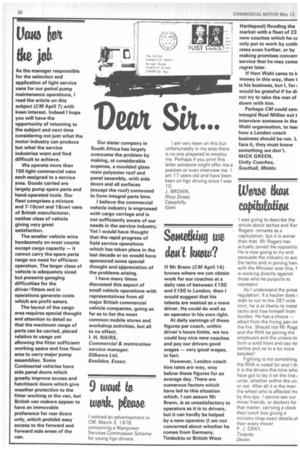Van lion
Page 38

If you've noticed an error in this article please click here to report it so we can fix it.
As the manager responsible for the selection and application of light service vans for our petrol pump maintenance operations, I read the article on this subject (CM April 7) with keen interest. Indeed I hope you will have the opportunity of returning to the subject and next time considering not just what the motor industry can produce but what the service industries want and find difficult to achieve.
We operate more than 100 light commercial vans each assigned to a service area. Goods carried are largely pump spare parts and hand-operated tools. Our fleet comprises a mixture and 7-10cwt and 18cwt vans of British manufacturer, neither class of vehicle giving very great satisfaction.
The smaller vehicle wins handsomely on most counts except cargo capacity — it cannot carry the spare parts range we need for efficient operation. The larger class of vehicle is adequately sized but presents garaging difficulties for the driver /fitters and in operations generate costs which are profit eaters.
The layout of the cargo area requires special thought and attention to detail so that the maximum range of parts can be carried, placed relative to usage yet allowing the fitter sufficient working space and free floor area to carry major pump assemblies. Some Continental vehicles have side panel doors which greatly improve access and hatchback doors which give weather protection to the fitter working at the van, but British van makers appear to have an immovable preference for rear doors only, which prohibit easy access to the forward and forward side areas of the van.












































































































